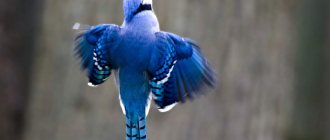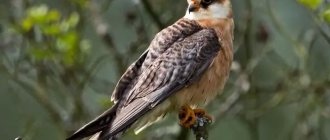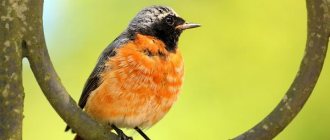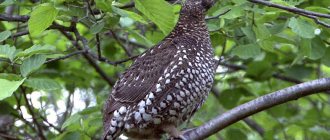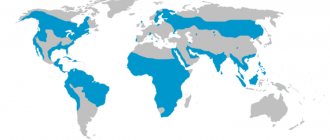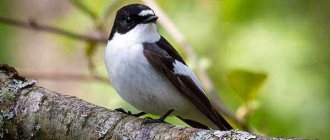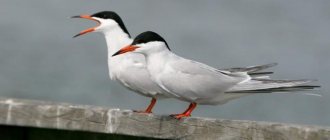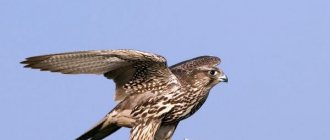- Wild animals
- >>
- Birds
The spotted eagle is a large bird of prey. Like all typical eagles, it belongs to the hawk family. Typical eagles are often grouped with buzzards, bald eagles and other members of the family, but they appear to be less distinct from the slimmer hawks than had been thought. Spotted eagles live primarily in patchy forest areas, meadows, fields and natural pastures, often in damp environments.
Origin of the species and description
Photo: Spotted Eagle
Based on an analysis of mitochondrial sequences of greater spotted eagles conducted in Estonia from 1997-2001, researchers found much greater genetic diversity in this species than in a larger sample of lesser spotted eagles.
They suggested that colonization of northern Europe occurred earlier in this species than in the crested eagle, which lives to the east of the greater spotted eagle. They also suggested that it prefers nesting in birch and pine trees, which extend further to the north, rather than in broad-leaved trees, as is the case with lesser spotted eagles.
Video: Spotted Eagle
The maximum lifespan of spotted eagles is from 20 to 25 years. Threats include local habitat conditions, abundance of prey, deliberate poisoning and hunting. Average annual mortality is 35% per year for juveniles, 20% for immature birds and 5% for adults. Because of these threats, their average lifespan is usually between 8 and 10 years.
Spotted eagles are the top predators in their ecosystem. They help control populations of small mammals and other small vertebrates. Spotted eagles can be beneficial to farmers because they eat rabbits and other rodents, small birds, insects and reptiles that threaten crops.
Distribution and habitat
It is a type of wooded country. The population is entirely migratory. Breeds from northern Europe east through Eurasia, and in winter in southeastern Europe, northeast Africa, the Middle East and the Indian subcontinent. Migration to breeding grounds occurs quite late; in Bhutan, for example, birds can be seen with some regularity until the end of March.[9]
Movements
This species is prone to vagrancy. Its usual breeding range no longer extends as far west as Germany but birds can still be seen there from time to time, with few records per decade. Even young birds scatter widely; in the Staatliches Museum für Tierkunde Dresden there is a copy (C 21845), taken in November 1914 in Bernsdorf in Saxony. It is a juvenile, and although its exact age cannot be determined, it is heavily spotted and probably less than 20 months old.[10]
In 1993, an adult great spotted was tagged with a satellite transponder to track its migration. The tagged eagle has migrated a total of 5,526 km (3,434 mi) from its wintering grounds in Yemen to its breeding grounds in western Siberia. It moved an average of 150 km (93 mi) each day, but this increased to 280 km (170 mi) per day as the bird flew through Mesopotamia.[11]
Appearance and features
Photo: What a spotted eagle looks like
There are such types of spotted eagles:
- greater spotted eagle;
- lesser spotted eagle.
Greater and lesser spotted eagles look the same. Their wingspan is 130-180 cm. The plumage of adults is completely brown, while young birds are more or less covered with light spots. In appearance, spotted eagles resemble the common buzzard, and from a distance the species can be distinguished only by their silhouette during flight: while the spotted eagle usually lowers the tips of its wings as it glides, the common buzzard usually holds them up.
Looking at the birds at closer distances, one will notice that the common buzzard usually has a predominant white color in its plumage, while spotted eagles are usually uniformly brown and have only a few white spots on their feathers. Upon even closer inspection, the observer will find that the spotted eagle's feet are covered with feathers up to the toes, while the feet of the common buzzard are featherless.
Based on plumage symbols, including the wing bar, we can easily rule out the steppe eagle, which has few and sparsely spaced stripes on each feather compared to spotted eagles.
The Lesser Spotted Eagle has a lighter head and wings compared to the usually darker Greater Spotted Eagle. It has a uniform and dense band along the length of its primaries, while the Greater Spotted Eagle has a much thinner band that is mostly limited to the middle of its primaries, leaving the tips and base of its feathers unmarked. As with other large eagles, it is possible to determine the bird's age based on its plumage markings (for example, only juveniles have the characteristic white spots that give it its common name).
It is quite difficult to determine the difference between the two species of spotted eagles. Typically, the Greater Spotted Eagle is darker, larger, and more robust than the Lesser Spotted Eagle. It is also difficult to distinguish between them because they form mixed pairs that give birth to hybrids.
Description of the bird
There are two main types of spotted eagle – large and small. The difference between them, according to their names, is the size of the birds. The greater spotted eagle has a wingspan of 170 to 190 cm, weight is in the range of 2-4 kg, body length is 65-75 cm. The plumage is predominantly dark with light streaks. Individuals with light colored plumage are very rarely found.
— Advertising —
The Lesser Spotted Eagle is a smaller copy of the large one; the wingspan of this bird is from 100 to 130 cm, weight is from 1.5 to 2 kg, body length is 55-65 cm. The color of the plumage is no different.
Where does the spotted eagle live?
Photo: Greater Spotted Eagle
The spotted eagle nests in large moist deciduous forests bordered by wet meadows, swamps and other wetlands up to 1000 m. In Asia, it is found in taiga forests, forest-steppe with wetlands, wetlands and agricultural lands. Forest areas are preferable for them in winter. Migrating and wintering birds are sometimes found in more open and often drier habitats.
In their wintering range in Malaysia, these eagles live alone or in small groups. Although they forage individually, several individuals may wait peacefully in a loose group around a field in which a tractor is working. This species also frequents garbage dumps.
In Bangladesh, the birds are most often found along large rivers and estuaries, where they can be observed flying overhead or roosting on the ground on river banks or river islands. In Israel, during winter in the lowland Mediterranean climate, the birds can be found in valleys and wet open areas, mainly in cultivated fields and fish ponds near areas of trees, mainly eucalyptus.
In Russia they are found in forests, forest-steppes, river valleys, pine forests, small steppe forests in humid areas and forest swamps. In Kazakhstan - in coastal forests, lowland steppes and forest steppes.
Population control
The Greater Spotted Eagle is better distributed than the Lesser Spotted Eagle, but its population continues to decline towards the west. The reasons for this are environmental change, deforestation, drainage of swamps, hunting, poisoning, shooting.
New species that appeared by crossing the Greater and Lesser Spotted Eagles are moving westward due to the genes of the Greater Spotted Eagle. A plan has been created for spotted eagles in the European part. The Greater Spotted Eagle is considered vulnerable, but it is distributed in the Western Siberian Lowland. There is a possibility that it numbers about 10,000 individuals.
This is why this population can be included on the endangered list, because 10,000 is the lower threshold for inclusion on the vulnerable list.
Most regions have taken measures to preserve the spotted eagle population, especially in Belarus. Belarusian legislation protects the Greater Spotted Eagle, but it is too complex to implement. The legislation states that specially controlled areas can be those that have become home to birds, which have been documented and approved by all institutions and authorities. This may take about nine months.
There is a program in Germany that is trying to increase the spotted eagle population by hand raising the second chick born. After some time, the cub is returned to the nest. The first born chick stops being aggressive and they live together. Nature's preservation of its habitat is of great importance for the survival of spotted eagles in Germany.
The spotted eagle is a small eagle that builds nests in forests, swamps, meadows, and fields. During the mating season, the species is distributed from Eastern Europe to China, but is most common in Russia and Belarus.
What does a spotted eagle eat?
Photo: Lesser Spotted Eagle
Spotted eagles typically hunt their prey in grasslands that are not protected, as well as in swamps, fields and other open landscapes, and often even in forests. Their hunting grounds are usually located near nests, located at a distance of up to 1-2 km from the nesting site.
The spotted eagle usually hunts its prey in flight or by stalking it in trees located near forest edges and other higher places (lonely trees, hayfields, electric poles). Sometimes the bird gets prey that walks on the ground. The spotted eagle actively hunts its prey by flying or walking when food resources are scarce, but when resources are rich it chooses to pursue the prey.
Their main diet consists of:
- small mammals the size of a hare, such as voles;
- amphibians such as frogs;
- birds (including waterfowl);
- reptiles, for example, snakes, lizards;
- small fish;
- larger insects.
In many areas, the spotted eagle's main prey item is the northern water vole (Arvicola terrestris). The birds overwintering in Malaysia fed on carrion, mainly dead rats that had been poisoned in agricultural areas. This species engages in kleptoparasitism from each other and from other predator species.
Behavior
In the winter range the species is more social than during breeding. Small flocks of up to ten birds of varying ages can be seen patrolling the ground together. They also associate with other Accipitridae such as local and/or migrant black kites ( Milvus migrans lineatus
and
Govinda
) or steppe eagles (
A. nipalensis
), distinctly smaller and larger raptors, respectively.[9]
Feeding
The eagle hunts small mammals and similar, mostly terrestrial, prey.
Breeding
Egg, Collection Wiesbaden Museum
This eagle lays 1–3 eggs in a tree nest. Generally territorial, juveniles spend some time with their parents after fledging until they reach sexual maturity and look for a territory and a mate.
Features of character and lifestyle
Photo: Spotted Eagle Bird
Spotted eagles are migratory birds. They winter in the Middle East, Southern Europe, Central and Southern Africa. Migration to and from Africa occurs mainly through the Bosphorus, the Middle East and the Nile Valley. The Greater Spotted Eagle arrives back from wintering at the end of March, and the Lesser Spotted Eagle can be seen a little later - in early April. Both species migrate in September, but individual birds can still be seen in October.
Fun Fact: Spotted eagles are usually found alone or in pairs, but they congregate near large food sources and migrate in flocks.
Spotted eagles live in a mosaic landscape where forests alternate with meadows, pastures, fields, river valleys and swamps. They are more adapted to life on agricultural lands than their larger relatives. Birds usually build their own nests and occupy them continuously in subsequent years, especially if they are not disturbed. Sometimes they use old nests of other birds of prey (common buzzard, northern hawk) or black stork. Sometimes a pair of spotted eagles has several nests, which are used alternately in different years.
Fun fact: Spotted eagles are very territorial. They will fight other birds that get too close to their nests. Males are more aggressive than females and tend to exhibit territorial behavior only towards other males. Females often visit the nests of other females during the breeding season.
Bird distribution
The spotted eagle's habitat is quite wide. The birds are distributed from Finland all the way to the coast of the Azov Sea. In addition, the predator is found in China and Mongolia. It is in Mongolia that the spotted eagle is actively tamed and used by local residents for hunting and protecting their homes from wolves.
Spotted eagles are migratory birds that go to wintering grounds in India, Africa, and the countries of the Middle East (Pakistan, Iraq, Iran, the Indochina Peninsula).
The spotted eagle cannot live in steppes or deserts, since the bird builds its nests on tall trees. In such conditions, it can only be found near rivers, where the spotted eagle finds suitable places for nesting. In the northern regions of their habitat, birds settle on the edges of forests, which border on meadows and fields, and sometimes even swamps.
Social structure and reproduction
Photo: Great spotted eagle bird
Spotted eagles begin building or repairing a nest immediately upon arrival. By the end of April or beginning of May, a full clutch contains one or two (very rarely three) eggs. The female begins to incubate them immediately after laying the first egg, which is why the chicks hatch at different times. The hatching process lasts 37-41 days. The chicks can fly at the age of 8-9 weeks, which usually coincides with the first half of August. Of the chicks, one, or very rarely two, learn to fly.
The breeding success of spotted eagles has a three-year cycle, driven by changes in the number of voles, the eagles' preferred prey. In the best years, production can average over 0.8 paired young birds, but during low cycles this number can drop to below 0.3. Greater spotted eagles are sensitive to disturbance and have low breeding success. Although they lay two eggs, often only one chick fledges.
Fun Fact: Where spotted eagle populations are struggling, their productivity can be artificially increased by ensuring both chicks survive fledging. In the wild, one is almost always lost due to fratricide, known as cainism.
Systematics, taxonomy and evolution
Typical eagles are often grouped with buteos ( Buteo
), sea eagles (
Haliaetus
) and other heavier Accipitridae, but they may be less distinct than previously thought from the slimmer hawksbills. The Lesser Spotted Eagle is the closest living relative of the Greater Spotted Eagle; their common ancestor appears to have diverged around the mid-Pliocene, perhaps around 3.6 million years ago (Ma), [note 1] from the ancestors of the Indian spotted eagle living in a band from Iran to and India. The "proto-pied eagle" probably lived in the general region of Afghanistan, splitting into northern and southern lineages when both glaciers and deserts advanced into Central Asia as the last ice age began. The northern branch subsequently split into eastern (large) and western (small) modern species, probably around the Pliocene period. The Pleistocene boundary is not quite 2 m.[6][7][8]
Spotted eagles as a group, although quite different from typical members, were previously included in this genus. Aquila
, "real eagles".
They are now placed in a separate genus. Clanga
Natural enemies of spotted eagles
Photo: Spotted Eagle Bird
The young and eggs of Greater Spotted Eagles can be preyed upon by American mink and other predators. Chicks may be targeted by other predators or owls. Otherwise, greater spotted eagles are the main predators, and adults are not usually preyed upon by other large predators.
Lesser Spotted Eagles have no natural predators and do not display obvious adaptations against them. The main threat to them is people. They pose a risk to spotted eagles due to the use of chemicals such as azodrine, an organophosphate insecticide used to prevent small animals from feeding on crops. Predators, including lesser spotted eagles, often die from feeding on these poisoned animals. Another human influence on this species is hunting.
Another cause of mortality in lesser spotted eagles is fratricide. If there are two or three eggs in a nest, usually the offspring that hatch first will kill the others first by knocking them out of the nest, attacking them, or eating food before their siblings have a chance to eat. As a result, most spotted eagles successfully raise only one or two offspring.
It has been suggested that Lesser Spotted Eagle eggs may be eaten by other animals, particularly snakes. However, this has not been clearly documented. Greater Spotted Eagle eggs are eaten by American minks. Therefore, it is possible that minks may also hunt Lesser Spotted Eagle eggs.
The main threats to the species are habitat loss (particularly drainage of rainforests and grasslands and ongoing deforestation) and hunting. The latter threat is particularly prevalent during migration, with thousands of birds being shot each year in Syria and Lebanon. Forest management activities have been reported to have negative impacts on the species. It is also highly vulnerable to the impacts of potential wind energy development. The Chernobyl accident may have had a negative impact on this species.
Interesting Facts
- Previously, white, cream and light brown spotted eagles were considered sacred birds, serving the will of the gods. In the Middle Ages, they were even domesticated, since they were a recognized element of the owner’s wealth and well-being.
- Due to widespread deforestation and air poisoning, the spotted eagle population has declined. Now these representatives can be found on the Red Book page. The species of Greater Spotted Eagle is at the stage of extinction, despite its wide habitat.
Population and species status
Photo: What a spotted eagle looks like
The Greater Spotted Eagle is listed as an endangered species worldwide. Its global population has been estimated to range from 1,000 to 10,000 individuals, but speculation suggests that a higher figure is unlikely. BirdLife International (2009) estimates the number of adult birds to be between 5,000 and 13,200. BirdLife International/European Bird Census Council (2000) estimates the European population was estimated at 890–1100 breeding pairs, later revised to 810–1100 breeding pairs.
The Lesser Spotted Eagle is considered the most numerous eagle species in Europe. The species was not previously as widespread as it is today, and its numbers declined further in the first half of the 20th century as a result of "hawk war". After this, the population gradually recovered. In the 1960s and 1970s, there was a shift in ecological niche: eagles began nesting near the cultural landscape. Thereafter, during the 1980s, the number of lesser spotted eagles probably increased rapidly. Currently, the largest habitat areas of the Lesser Spotted Eagle are located in Belarus, Latvia and Poland.
The Lesser Spotted Eagle has an extremely large range and therefore does not approach the range size thresholds for vulnerable (occurrence rate <20,000 km² combined with decreasing or fluctuating range size, habitat extent/quality or population size and a small number of sites or severe fragmentation). The population of spotted eagles is about 40,000-60,000 individuals. The population trend of Lesser Spotted Eagles is unknown, but it is not believed to be declining rapidly enough to approach demographic thresholds (>30% decline over ten years or three generations).
Population size can range from moderately small to large, but is not considered to approach thresholds for vulnerable based on the population size criterion (<10,000 mature individuals with a continuing decline estimated at >10% over ten years or three generations). For these reasons, the species is assessed as least threatened.
Recommendations
- ^ a b
BirdLife International (2013).
" Clanga Clanga
".
IUCN Red List of Threatened Species
.
2013
. Retrieved November 26, 2013.CS1 maint: ref=harv(link)Old form URL - Jobling, James A. (2010). Helm Dictionary of Scientific Names for Birds
. London: Christopher Helm. clause 110. ISBN 978-1-4081-2501-4. - Ferguson-Lees, J.; Christie, D. (2001). Predators of the world
. Houghton Mifflin Harcourt. ISBN 0-618-12762-3. - Dunning, John B. Jr., ed. (1992). CRC Handbook of Avian Body Masses
. CRC Press. ISBN 978-0-8493-4258-5. - Vyali, Yulo; Lõhmus, Asko (2004). “Chicks and identification of the Lesser Spotted Eagle. Aquila pomarina
, Greater Spotted Eagle
A. clanga
, and their hybrids."
Journal of Ornithology
.
145
(3):256–263. doi:10.1007/s10336-004-0028-7. S2CID 20893726. - Parry, S. J.; Clark, W. S.; Prakash V. (2002). “On the taxonomic status of the Indian spotted eagle. Aquila hasstata
".
Ibis
.
144
(4):665–675. Doi:10.1046/j.1474-919X.2002.00109.x. - Rasmussen, Pamela K.; Anderton, John S. (2005). Birds of South Asia - Ripley's Guide
. Barcelona: Lynx Editions. ISBN 84-87334-67-9. - Väli, Yulo (2006). "Mitochondrial DNA sequences confirm the species status of the Indian spotted eagle Aquila hastata
."
Bulletin of the British Ornithologists' Club
.
126
(3): 238–242.CS1 maint: ref=harv (communication) - ^ a b
Bishop, K. David (1999).
"Preliminary notes on some birds in Bhutan" (PDF). Fork
.
15
: 87–91. Archived from the original (PDF) on July 26, 2014. Retrieved July 18, 2014. - Töpfer, Till (2007). "Nachweise seltener Vogeltaxa (Aves) in Saxony aus der ornithologischen Sammlung des Museums für Tierkunde Dresden" [Records on taxa of rare birds (Aves) in Saxony from the ornithological collection of the Zoological Museum Dresden]. Faunistische Abhandlungen
(in German and English).
26
(3): 63–101. - Meyburg, Bernd-U.; Eichaker, Xavier; Meyburg, Christiane; Paillat, Patrick (1995). "Tracking satellite migrations of an adult spotted eagle" (PDF). British birds
.
88
: 357–361. - Vyali, Yulo; Lõhmus, Asko (2000). “Suur-konnakotkas ja tema kaitse Eestis” [The Greater Spotted Eagle and its conservation in Estonia]. Hirundo
. Supplement 3: 1–50.
Habitat
You can meet the Greater Spotted Eagle in forests and forest-steppe areas. Inhabitants of Russian latitudes nest in the European region near the Volga in the Urals and the Yenisei valley in the Baikal region. Outside Russia, they can be found in western Poland, Finland, Yugoslavia and Romania. Part of the population is located in eastern China.
Greater spotted eagles use high-leaved forests, which are located in river valleys and wetlands, as nesting areas. The presence of meadows, clearings, swamps and wastelands is important for them, since in such regions they find a large amount of food. Some representatives are found at altitudes of up to a thousand meters above the sea.

